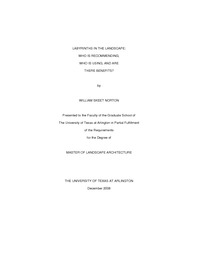
ATTENTION: The works hosted here are being migrated to a new repository that will consolidate resources, improve discoverability, and better show UTA's research impact on the global community. We will update authors as the migration progresses. Please see MavMatrix for more information.
Show simple item record
| dc.contributor.author | Norton, William Skeet | en_US |
| dc.date.accessioned | 2009-09-16T18:20:28Z | |
| dc.date.available | 2009-09-16T18:20:28Z | |
| dc.date.issued | 2009-09-16T18:20:28Z | |
| dc.date.submitted | January 2008 | en_US |
| dc.identifier.other | DISS-10129 | en_US |
| dc.identifier.uri | http://hdl.handle.net/10106/1866 | |
| dc.description.abstract | The labyrinth is a symbol known to exist for at least for four thousand years. It has been used in many cultures and religions throughout its existence as a symbol for the journey of life, a sacred space to pray, and a place of meditation and contemplation. After several hundred years of absence, the labyrinth is regaining popularity in modern cultures and religions, and is thought to be beneficial to the mind, body, and spirit. Many of the contemporary labyrinths are in the outdoor-built environment. This research assists landscape architects in understanding who is recommending labyrinths, using labyrinths, and the benefits of labyrinths. Literature on the subject of the labyrinth is investigated to understand current research about the labyrinth and its history, forms, materials, uses, benefits, and users. The literature explores and suggests ideas for future research related to labyrinths and the practice of landscape architecture. A qualitative approach is applied to this research. In-depth interviews were conducted with twelve key informants at five study sites in the Dallas/Fort Worth metropolitan area. Labyrinths at two hospital settings, two church settings, and one college campus were chosen for study. The data, analyzed qualitatively, revealed that the people who commission labyrinth projects have a very specific knowledge of the subject and are seeking to enhance their organization by providing an interfaith space for walking meditation, contemplation, and relaxation. The users can be individuals or groups; one of the uses most often cited is walking meditation. The benefits of using labyrinths are somewhat unique to the individual user and are therefore hard to measure.This research concludes with ideas for future research to clarify unknowns established while conducting this research. The intent is to inspire further research related to labyrinths and their use as design elements by landscape architects. | en_US |
| dc.description.sponsorship | Hopman, David | en_US |
| dc.language.iso | EN | en_US |
| dc.publisher | Landscape Architecture | en_US |
| dc.title | Labyrinths In The Landscape: Who Is Recommending, Who Is Using, And Are There Benefits | en_US |
| dc.type | M.L.A. | en_US |
| dc.contributor.committeeChair | Hopman, David | en_US |
| dc.degree.department | Landscape Architecture | en_US |
| dc.degree.discipline | Landscape Architecture | en_US |
| dc.degree.grantor | University of Texas at Arlington | en_US |
| dc.degree.level | masters | en_US |
| dc.degree.name | M.L.A. | en_US |
| dc.identifier.externalLink | http://www.uta.edu/ra/real/editprofile.php?onlyview=1&pid=1131 | |
| dc.identifier.externalLinkDescription | Link to Research Profiles | |
Files in this item
- Name:
- Norton_uta_2502M_10129.pdf
- Size:
- 6.019Mb
- Format:
- PDF
This item appears in the following Collection(s)
Show simple item record


